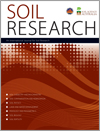Several synthesis studies reported that increases in soil organic carbon occur under organic agriculture, but it is unclear whether these increases can be achieved without carbon transfer from outside the organic farm. The meta-analysis of published data from field experiments showed that organic carbon is higher under organic than conventional farming only if there are carbon transfers from other production systems. When evaluating the carbon sequestration potential of organic agriculture, the off-site effects of the production system must be considered.

Soil Research
Volume 60 Number 3 2022
Removal of gravel by sieving soil to 2 mm is common practice for nutrient analysis and estimation of carbon (C) and nitrogen (N) stocks in agricultural soils. Organic matter (OM) associated with gravel contributed ∼20% to the total C and N stocks in a cropping soil to 180 cm. Gravel-associated OM had C:N ratio similar to fine-earth-fraction soil OM and contributed ∼5% of C in surface soil and up 40% at depth. Gravel-containing soils are widespread and exclusion of the gravel fraction leads to a significant underestimation of total C and N stocks.
SR21140 Abstract | SR21140 Full Text | SR21140PDF (1.9 MB) | SR21140Supplementary Material (698 KB) Open Access Article
Biochar or pumice soil amendment technology is attracting interest for its potential to improve soil water retention and mitigate salinity stress. However, there is little information on how their use affects water-borne salt transport in sandy soils under arid conditions. We found that their relatively high ultramicro-scale and micro-scale porosity contributes to the water retention when applied to the sandy soils, and to the dilution of salinity in salt-affected soils – useful knowledge for soil remediation for salt-affected arid agriculture.
SR20327 Abstract | SR20327 Full Text | SR20327PDF (6.8 MB) | SR20327Supplementary Material (616 KB) Open Access Article
The specific contribution of mineral ash and carbon skeleton (representing the refractory carbon pool in biochar) to biochar-induced phosphate sorption was delineated. The biochar skeleton showed nearly zero phosphate sorption after equilibration with phosphate solution, and had little effect on phosphate sorption of two different paddy soils. Phosphate sorption caused by biochar mineral ash was impacted by soil phosphorus-retentive properties such as amorphous iron and aluminum minerals.
SR21101The fate of urea 15N in a subtropical rain-fed maize system: influence of organic amendments
Nitrogen fertilisers play an important role in sustainable maize production. Over 30% of applied nitrogen was lost by the end of the season. Reducing N losses is critical for profitable and environmentally friendly food production.
Tracing methods using natural soil chloride were used to estimate the amount of water lost below the crop root zone (deep drainage) for tillage, compaction, and farming systems (winter, summer, or opportunity cropping and pasture) treatments. Zero tillage, no compaction, and winter cropping/summer fallows had greater deep drainage than conventional tillage, compacted soil, and summer or opportunity cropping. Summer and opportunity cropping, and ley pastures, can reduce deep drainage to low levels, while still using zero tillage and controlled traffic.
SR21084 Abstract | SR21084 Full Text | SR21084PDF (3.6 MB) Open Access Article
Biological agent could change soil microbial structure, microbial diversity and characteristics of carbon source utilisation. There was a positive correlation between microbial diversity and soil enzyme activity. Biological agent could enhance tree vigor and improve fruit quality of root-rot plants.
Soil organic matter and microbial attributes are key indicators of ecosystem response to environmental and management changes. Although there are conflicting reports regarding effects of conservation agriculture, our results show that tillage and temporal variability influenced soil quality, largely in the upper 5 cm soil. This study is a fitting addition to knowledge on reversing soil degradation in semi-arid agro-ecosystems.
Seeded plant stands and mulches employed as soil covers in semi-arid orchards for erosion control can also affect biological parameters and soil health. Soil free-living nematodes, key to the flow of matter and energy in soil food-webs, respond to changes in the availability of water and carbon in soils. All soil covers can offer some protection against erosion but also accelerate matter turnover; plant covers favour rapid, bacterial pathways of carbon degradation while mulches might favour plant pathogens.




